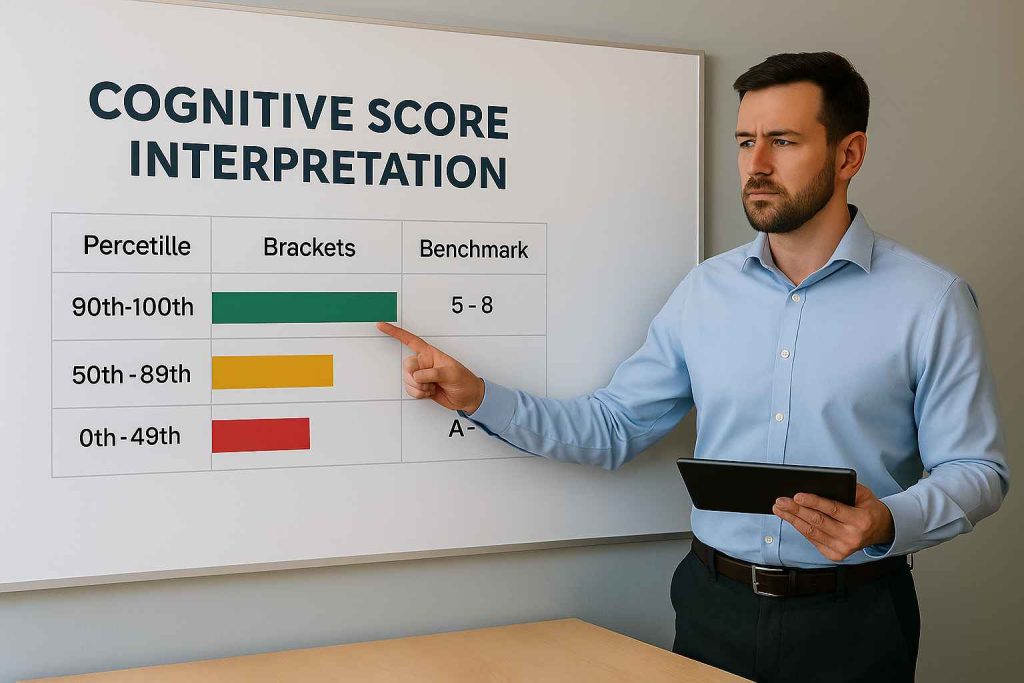So you’ve given a candidate a cognitive assessment—great move. But now what? You’re staring at a percentile, a raw score, or maybe even a color-coded bar graph… and you’re wondering, what does this actually tell me about this person’s ability to do the job?
This guide breaks it all down. We’ll walk you through what cognitive assessment scores mean, how to interpret them correctly, and how to use them in real hiring decisions—without overthinking the numbers.
First, A Quick Recap: What’s a Cognitive Assessment?
Before we decode the scores, let’s quickly revisit what a cognitive test actually measures.
Cognitive assessments evaluate core thinking skills such as:
- Problem-solving
- Logical reasoning
- Numerical and verbal ability
- Pattern recognition
- Learning speed
- Attention to detail
If you’re new to the topic, check out our pillar guide on cognitive ability to get the full picture.
What Kind of Scores Do These Tests Give?
Cognitive assessments can report results in a few different ways. Here’s a breakdown:
| Score Type | What It Means | Example |
| Raw Score | Number of correct answers | 42 out of 50 |
| Percentile Score | How a candidate compares to others | 85th percentile = scored better than 85% of test-takers |
| Scaled Score | Adjusted score to standardize difficulty | Scale of 200–800 |
| Banding Score | Categorized score ranges (e.g., Low, Average, High) | Band 3 = Above Average |
| Sub-scores | Breakdown by skill type (logic, math, verbal, etc.) | Verbal: 78%, Logical: 92% |
Different platforms use different formats, but most follow this logic. You can dive deeper into formats in our cognitive assessment scale guide.
How to Interpret Cognitive Assessment Scores (Without Overthinking It)
The key to interpreting scores is context. A 60% might be good in one hiring situation and weak in another. Here’s a simple way to make sense of it all:
1. Compare Against Benchmarks
Always compare a candidate’s score against a relevant benchmark. For example:
| Role | Average Score Benchmark | Ideal Range |
| Data Analyst | 75–85% | 85–95% |
| Customer Support | 60–75% | 70–85% |
| Entry-Level Sales | 50–65% | 65–80% |
Want to see real test content? Check out examples of cognitive assessments in hiring.
2. Don’t Judge on One Score Alone
If a candidate scores lower in numerical reasoning but higher in pattern recognition, and the job relies more on adaptability than math—they might still be a great fit.
That’s why using cognitive behavioral assessments or combining cognitive with personality or situational judgment tests gives you a fuller picture.
3. Look for Patterns Across Candidates
Instead of just ranking candidates by score, look for trends:
- Who consistently performs above average?
- Who has a sharp spike in one skill area?
- Who’s improving on retests?
This makes it easier to shortlist effectively, especially when hiring at scale using pre-employment cognitive assessments.
What’s Considered a “Good” Score?
Here’s a general cheat sheet:
| Score Type | What It Suggests |
| 90th percentile+ | Exceptional thinker, very high ability |
| 75th–89th | Strong candidate, likely a top performer |
| 50th–74th | Average to slightly above-average range |
| Below 50th | May need more training or coaching |
But again—don’t rule someone out based solely on this. Combine it with interviews, reference checks, and other test data.
For shorter tests, learn how quick cognitive assessments balance speed with reliability.
Use Scores with the Role in Mind
Always tie the score back to what the job actually demands. Here’s a quick mapping:
| Role Type | Prioritized Cognitive Area | Score Focus |
| Tech/Engineering | Problem-solving, logic | Logical & numerical sub-scores |
| Admin/Data Entry | Attention to detail | Accuracy-based test results |
| Leadership | Decision-making under pressure | Overall composite + reasoning |
| Sales/Support | Verbal reasoning, adaptability | Verbal & learning speed |
For more, explore cognitive ability skills in the workplace.
What If a Candidate Scores Low?
Not every low score is a deal-breaker. Here’s what you can do:
- Re-assess using a different format (especially if test anxiety was likely)
- Pair with a behavioral test to evaluate soft skills
- Use as a development baseline for future training
Curious about test options? Top cognitive tools can offer flexible scoring formats and re-test settings.
Related Resources
- Cognitive Ability Test Questions and Answers (PDF)
- Types of Cognitive Tests
- Cognitive Assessment Examples
- How to Test Cognitive Skills for Employment
- Short Cognitive Assessments
- Cognitive Assessment Cost Guide
- Cognitive Assessment Interview Questions
FAQ
Can a candidate improve their cognitive score over time?
Yes, especially if the test focuses on reasoning speed or memory. Repeated exposure and practice help, but raw cognitive ability tends to remain relatively stable in adults.
What’s more important—percentile or raw score?
Percentile is more useful in comparing performance across candidates. Raw scores are good for tracking improvement in repeated tests.
How do I decide on cut-off scores?
Use benchmarks based on role requirements or industry standards. Avoid setting arbitrary cutoffs without validating them first.
Final Thoughts
Cognitive assessment scores are more than just numbers—they’re signals. Signals about how a candidate thinks, how quickly they learn, and how they’ll perform under real-world pressures.
When interpreted in context—and combined with other insights—they give you a huge edge in hiring smarter, faster, and fairer.If you’re building your test process or refining your evaluation strategy, dive into more insights in our cognitive assessment hub to sharpen your hiring toolkit.

